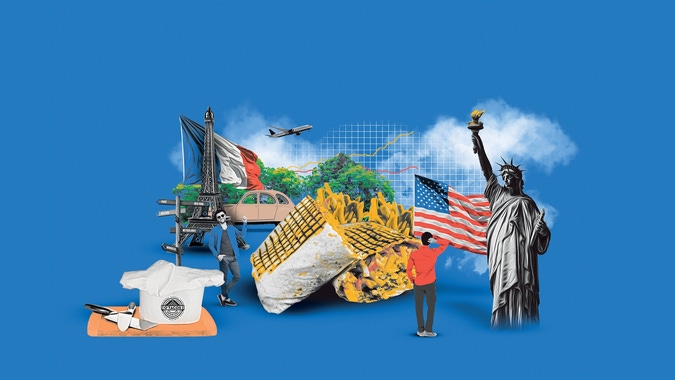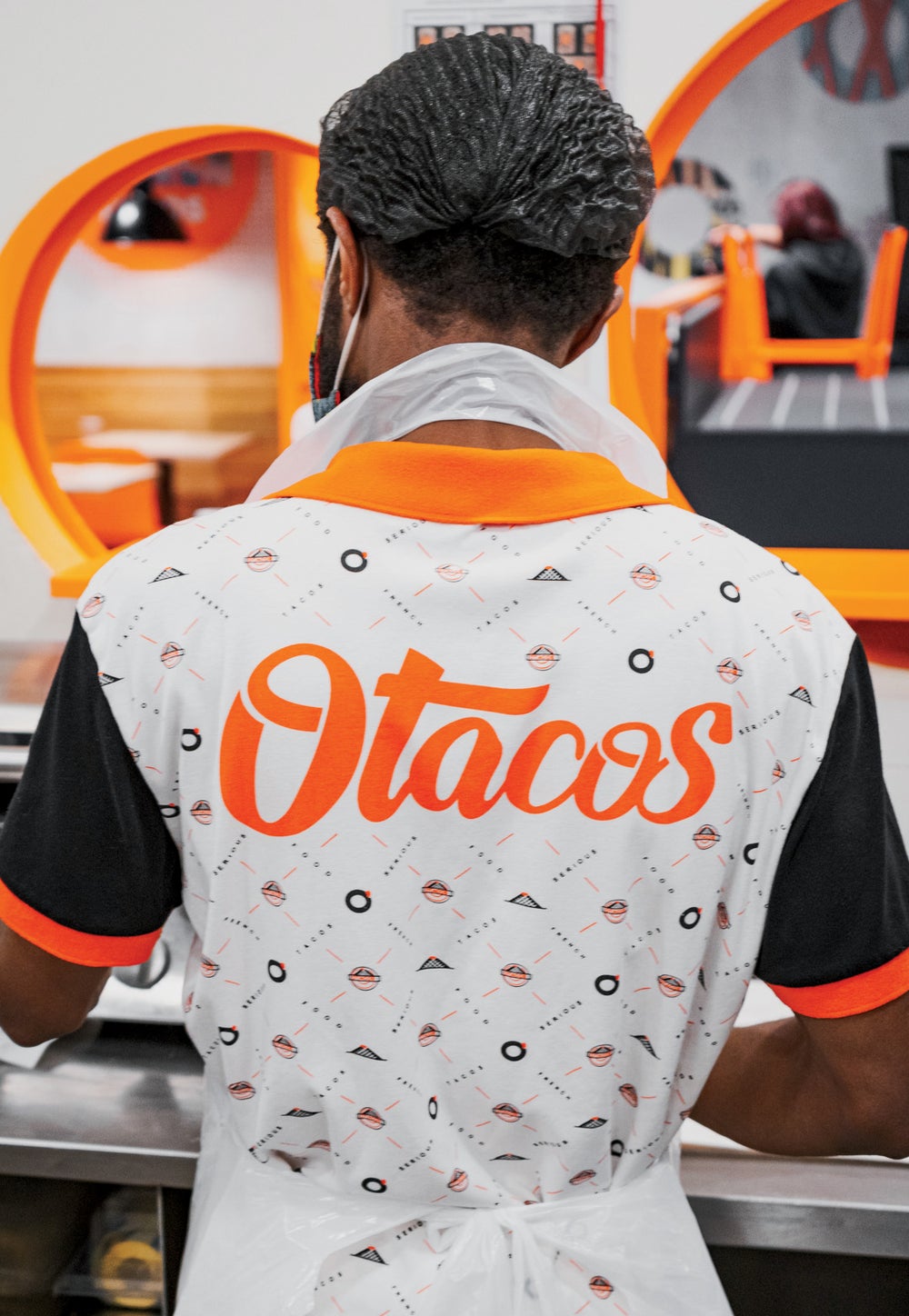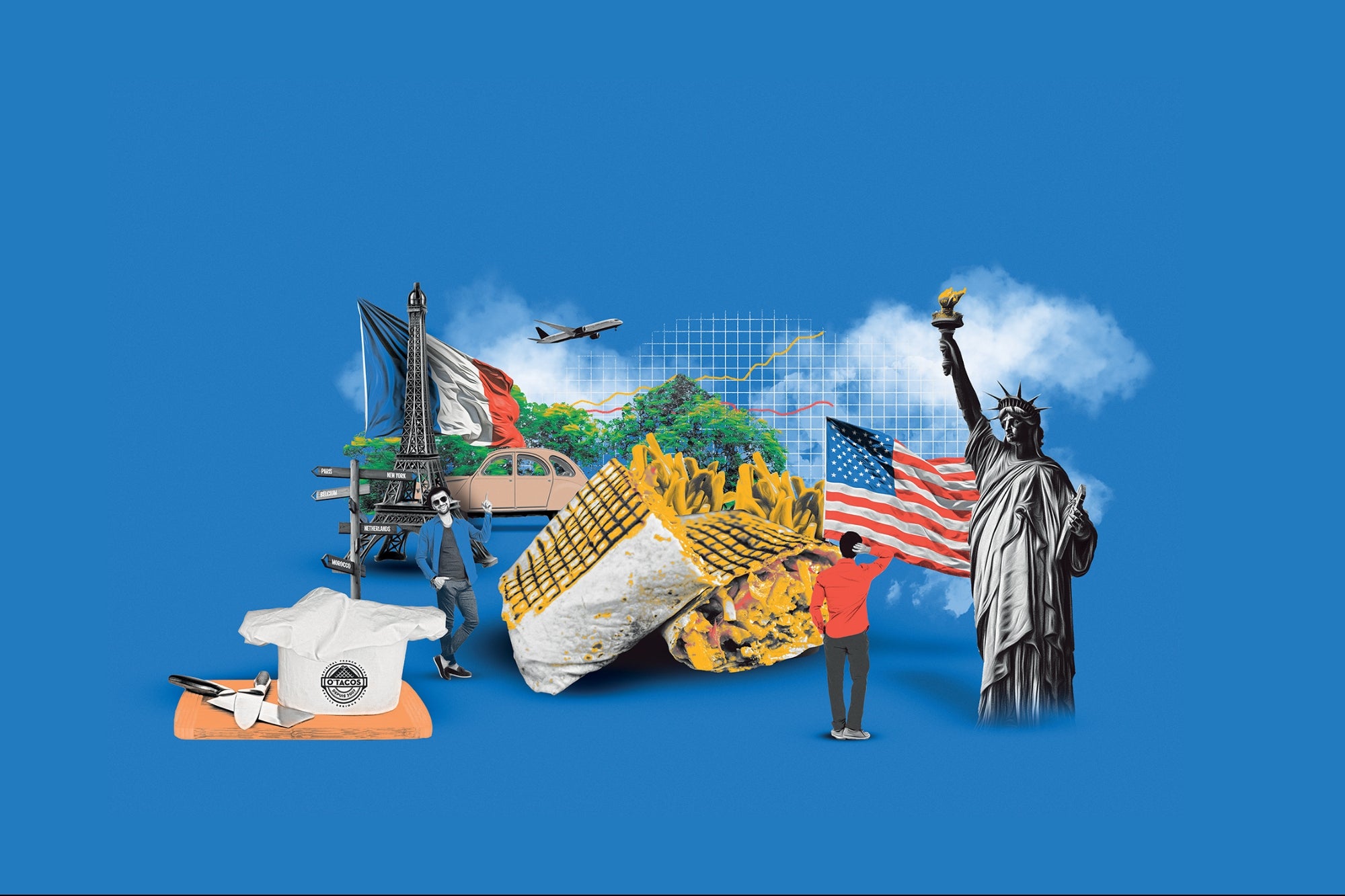These

What American fast-food connoisseur wouldn’t love a massive tortilla pouch packed with meat, oozy cheese, and fistfuls of fries? Overseas, “French tacos” are all the rage. The category is now just behind pizza and burgers across all delivery platforms in France, where Paris-based O’Tacos is gobbling up more than its share of the QSR market. Introduced in 2011 by two brothers in Bordeaux who were soon joined by a drywaller from Grenoble, O’Tacos has grown to 280 units across France, Belgium, the Netherlands, Luxembourg, and Germany, with annual revenue surpassing $300 million. O’Tacos grand openings — often celebratory events featuring French rap stars and Instagram influencers — are occurring in France reportedly at a faster rate than McDonald’s. Fans line up for hours to get their hands on the beefed-up poutine in a wrap.
 MAX-O-MATIC
MAX-O-MATIC
“In the beginning, it was a product that was very popular in the suburbs,” says Patrick Pelonero, the drywaller turned cofounder, though he means “suburbs” in the French sense, a more urban, working-class setting than the American definition. (We spoke through a translator.) “Now everybody knows it and everybody eats it.”
Related: Just How Much Does It Cost to Own a Fast-Food Franchise?
In 2017, O’Tacos opened 72 new locations in France. That March, it also decided to come to America. To do so, it set its sights where countless entrepreneurial dreamers had before: New York, that glittering melting pot of big ideas, fusion foods, outsize portions, and quick, tasty, eat-it-with-your-hands grub. O’Tacos seemed perfect for the market. But just 14 months later, as O’Tacos’ success continued to skyrocket overseas, its only U.S. location closed.
Now that failed experiment could serve as a stark lesson — for O’Tacos, and for any other aspiring franchises — about just how complicated international expansion is…and how much work must be done to find success.

Image Credit: Courtesy of O’Tacos
The appeal of entering the American franchise market is obvious. The U.S. is, for instance, about 18 times bigger than France, which is about equal in size to Texas. And so, according to research from the advisory firm FranData, each year roughly 30 brands from outside the country try to stake a claim stateside.
“It’s not a simple path, but it’s a clearly defined path,” says Darrell Johnson, franchise economist and CEO of FranData. Because modern franchising began in America nearly 100 years ago, Johnson explains, information and expertise are more readily available here, and the legal regulatory structure is solidly in place. There are at least 3,500 franchise brands operating in the U.S. today, more than any other country by a long shot. (Australia, the next closest, has about 1,100.)
“There’s plenty of opportunity,” Johnson says, pointing to success stories like Pollo Campero out of Guatemala, Bonchon out of South Korea, and Tim Hortons out of Canada. “I think the daunting part of it for most franchise brands internationally looking at the U.S. market is ‘How do I get started with this?’ ”
There are clear best practices, says Ray Hays, managing partner of FranLaunch USA, which focuses on bringing franchise concepts to America. “It’s not as much a matter of getting it the way you think is right,” Hays says. “It’s about avoiding doing things the wrong way when you enter the U.S. market.”
Related: What You Really Need to Look for When Considering a Franchise
Hays says that when brands stumble in the U.S., it’s typically because they struggled with one of four key principles: demonstrating proof of concept, creating a realistic financial plan, enlisting boots on the ground, or seeking legal guidance early on for both federal regulations and the abundance of state-specific laws.
“Finding U.S. partners and franchise experts on the ground in the U.S., I can’t stress that enough,” Hays says. “It’s absolutely critical, even for a very seasoned and established franchise that’s gone into
10 countries across Europe.”
No matter what, companies will also need to contend with the sheer scale of the United States — which can seem like a blessing from afar but a curse up close. For a 2018 article in Global Franchise magazine, Hays polled a handful of franchise CEOs from the United Kingdom — which is arguably closest to America’s franchise market in terms of culture and language — about what they didn’t realize before entering the U.S. “They say, you know, ‘This may sound really stupid, but I didn’t realize how big the United States was. I didn’t realize how diverse it was,’ ” Hays says. “Miami is a completely different market from Boston or New York or Chicago.” Instead of entering one country, it can feel like entering 10.
“The harsh reality is that very few Latin American and even European brands are actually ready or prepared to get into the U.S.,” says Fernando Lopez de Castilla, founder of Peru-based GNF Worldwide, which has guided nearly 3,000 franchises into more than 40 countries over the past decade.
De Castilla says it’s about discipline: Stick to an expansion-and-development plan, hire a good franchise lawyer, enlist consultants, and above all, resist shortcuts.
“What happens in many cases, even for the big brands, is they receive an attractive lead from an exotic place, or maybe a great place like New York or L.A., and it’s amazing how easily they disregard their previous homework and their plan and just want to have, let’s say, an overnight success. Just hitting the jackpot in that fabled place,” he says. “I don’t think life is like that, and franchising is definitely not like that.”
Opening a restaurant in one of the most dynamic cities in the United States was the furthest thing from Patrick Pelonero’s mind in 2007. He was just looking to make money when summer drywalling jobs dried up in the winter off-season in Grenoble, in the French Alps region that is credited with creating French tacos.
Pelonero began experimenting with his version of the recipe with a shop he called Tacos des Allies. Meanwhile, two brothers — Silman and Samba Traore — were essentially doing the same thing. The brothers opened the first O’Tacos location in Bordeaux, in 2011, before combining forces with Pelonero for O’Tacos in 2013.
Related: Interested in Starting a Business Overseas? Keep These 5 Things in Mind
They weren’t the only ones developing the market. Le Tacos de Lyon’s website says it created French tacos in Lyon in 1999 and now has four locations. Tacos Avenue is also eyeing international expansion, and there are other competitors, too. But the O’Tacos trio swiftly built a loyal following of young, working-class locals, who appreciated hearty food that didn’t eat up their paychecks. (Today the starting “medium” size goes for around €5, or roughly $6, and typically includes a choice of seven meats, 12 sauces, french fries, and a dozen or so add-ons.) Early fans also liked that the meat was (and still is) certified halal, appealing to suburban Muslim youth.
Perhaps most influential of all, Pelonero had also opened a marketing agency in 2010. O’Tacos became known for viral stunts like the five-pound, meat-laden “Gigataco” (free, if eaten by the two-hour deadline — a feat rarely accomplished) and emphasized the “experience” of the brand, not unlike America’s own Taco Bell. Rap music became embedded in the brand’s culture, in part because of Pelonero’s personal connections in the music industry. Today, the O’Tacos France home page features an interactive keyboard highlighting 42 available ingredients, each miked with sound. Users can choose a backdrop beat and record a 15-second rap.
In 2013, O’Tacos decided to franchise and opened a tiny location in Paris. That’s when all the ingredients really came together.
“It had people queuing up for hours, for more than 100 meters, to try the product. As of that moment, the whole brand was off for exponential growth,” Pelonero says. O’Tacos’ social media accounts gained 30,000 fans in six months, and as the brand grew, it deliberately focused on its roots. “It’s important, that connection, that link with urban youth, with the suburbs, that’s real,” says Pelonero. “Especially in this type of environment, people see whether it’s real or fake, and the moment you are not real, you lose a lot of credibility. So that’s a big part of the brand.”
In 2015, franchising began in earnest with 21 openings that year. By 2017 to 2018, O’Tacos had 220 locations. Yet on the development side, it was still just Pelonero and two interns. “It was a very lean structure, very entrepreneurial,” he says. “It’s the beginning of a startup that I think nowadays you mostly see within the tech industry, where things go very quickly, exponential, very small teams and a dedicated founder.”
It was around that time that a message from America arrived. A French native who’d been living in Brooklyn for 11 years wrote to the O’Tacos team, certain the brand would find a similar fan base there: urban, young, and driven; ethnically and culturally diverse. Pelonero flew to New York, and the two hit it off. “It was not something that had been planned very much in advance or a deliberate choice,” Pelonero says. “It was a nice opportunity. There was a good feeling between [me] and the partner from New York.” The Brooklyn location opened in the Crown Heights neighborhood in March 2017. Its storefront was slate-black with a clean O’Tacos logo — more spare French café than neon American chain store. The welcome was warm enough; the press, positive.
Related: 3 Steps to a Successful International Expansion
Pelonero returned to France, where O’Tacos was becoming more mainstream. The urban youth base was still strong, and the popularity had spread to city central office workers and families with kids. In 2018, Kharis Capital, a master franchisee for Burger King, staked majority ownership in the company, ushering in its expansion to Belgium and the Netherlands. O’Tacos moved its headquarters to Paris. It has also added the dessert subsidiary brand O’Sucre, which includes O’Taglace and O’Shakes.
Meanwhile, back in Brooklyn, people seemed to like the product. Sales were moderately steady, at $1,000 to $1,500 per day. But Pelonero says there were constant operational issues. The manager struggled to manage the lunch rush, and there wasn’t much the brand could do about a single location in a foreign country thousands of miles from headquarters. “It’s like raising a child on the other side of the Atlantic,” Pelonero says of the shuttered American location. “If none of the parents are there, it’s a bit more challenging.”
By May 2018, just more than a year after opening, O’Tacos closed its only U.S. location. It decided it was best to focus entirely on growing the business closer to home.
Of those 30 or so foreign brands that enter the U.S. market each year, FranData doesn’t track how many “succeed.” The factors are too nuanced and complex. “ ‘One and done’ is not a good way of assessing the market,” Johnson says. A single location isn’t a case study, nor is New York representative of the U.S. market. But if you can make it there, “it’s really a huge validation of your brand in just about any market,” Johnson says.
Related: How Food and Beverage Brands Handle Choice, Change and Amazon
Hays, too, believes that international franchises can do more than make it in the U.S. market — they can even dominate. He offers an example from outside the QSR realm: the 29-year-old Australian pool-cleaning concept, Poolwerx. Founder and CEO John O’Brien studied the U.S. market for nearly two decades before entering in March 2015. He selected key markets and expanded regionally by acquiring small, independent competitors to test the model. Only then did Poolwerx start franchising, adding 59 U.S. locations and becoming, per the company, the only global franchisor in the pool-and-spa aftermarket sector, with hundreds of retail and mobile units in Australia, New Zealand, and the U.S. The catch is it required deep pockets, which is one reason global brands may benefit from a U.S. partner; Poolwerx chairman of the Australian and U.S. boards Troy Hazard, himself an Australia-born serial entrepreneur, connected with the company in 2012 and became a U.S. citizen last year.
“They made mistakes, and it took longer than they expected and cost them more money, but fundamentally they did the right thing,” Hays says. “In the end, I do believe we’re going to see more and more foreign concepts in the U.S.”
This creates huge opportunity not just for global brands, says de Castilla, but for potential U.S. partners.
“There are amazing brands out there, amazing concepts and value propositions that experienced franchisors in the U.S. or experienced franchisees, especially multi-unit franchisees, could help develop and enter the States,” says de Castilla. Whether seeking U.S. partners or simply customers, he says, international brands would be wise to play up those cultural differences to stand out — a concept he refers to as a “country brand franchise” in his 2019 book La Biblia de las Franquicias (The Franchise Bible). That’s what GNF Worldwide client Juan Valdez has done in bringing its 400-unit, cooperative-owned Colombian coffee into almost 20 units across Florida, New York, and Washington, D.C., as it attempts its U.S. expansion.
“The brand’s pitch is that when you enter the Juan Valdez coffee shop, you aren’t just buying a coffee, you are buying a little taste of Colombia,” says de Castilla. Expertise is essential, but so is a specific, new vision. “That magic, or uniqueness, there are tons of brands that could actually bring that and make the melting pot richer and more tasty.”
Related: Why Franchising Is the Future of the Healthy-Fast-Food Movement
Though de Castilla, like Johnson and Hays, was unfamiliar with O’Tacos before we spoke, it seems that the company’s urban, blue-collar identity could be a great asset, should it give America another go. “I think that [O’Tacos’] concept is so good—actually, I got very hungry looking at the Instagram pictures,” says de Castilla. “But at the end of the day, you can have the best product in the world, but if you don’t do your homework, there is no luck in this industry.”
If he had it to do all over again, Pelonero says he’d get right back on that airplane to New York. But next time, he plans to do a few things differently. “We need the right partner to make it happen, and for real this time,” he says.
Pelonero also has three more years of international expansion under his belt since the Brooklyn location closed, and he’s confident in the product and how to market it. “The way of doing business is universal,” he says. With more than 2,500 employees serving 40,000 customers a day across five countries, he believes that successful reentry into the U.S. would require a strong local team that treats the business as if it were their own, better awareness of the market, and a “significant” number of locations. From there, the French tacos will take care of the rest.
“We’re actually more convinced than ever that it would be a great fit and a huge opportunity to go back to the U.S.,” Pelonero says. “So that’s definitely the plan, and one of the American dreams to still be realized.”





